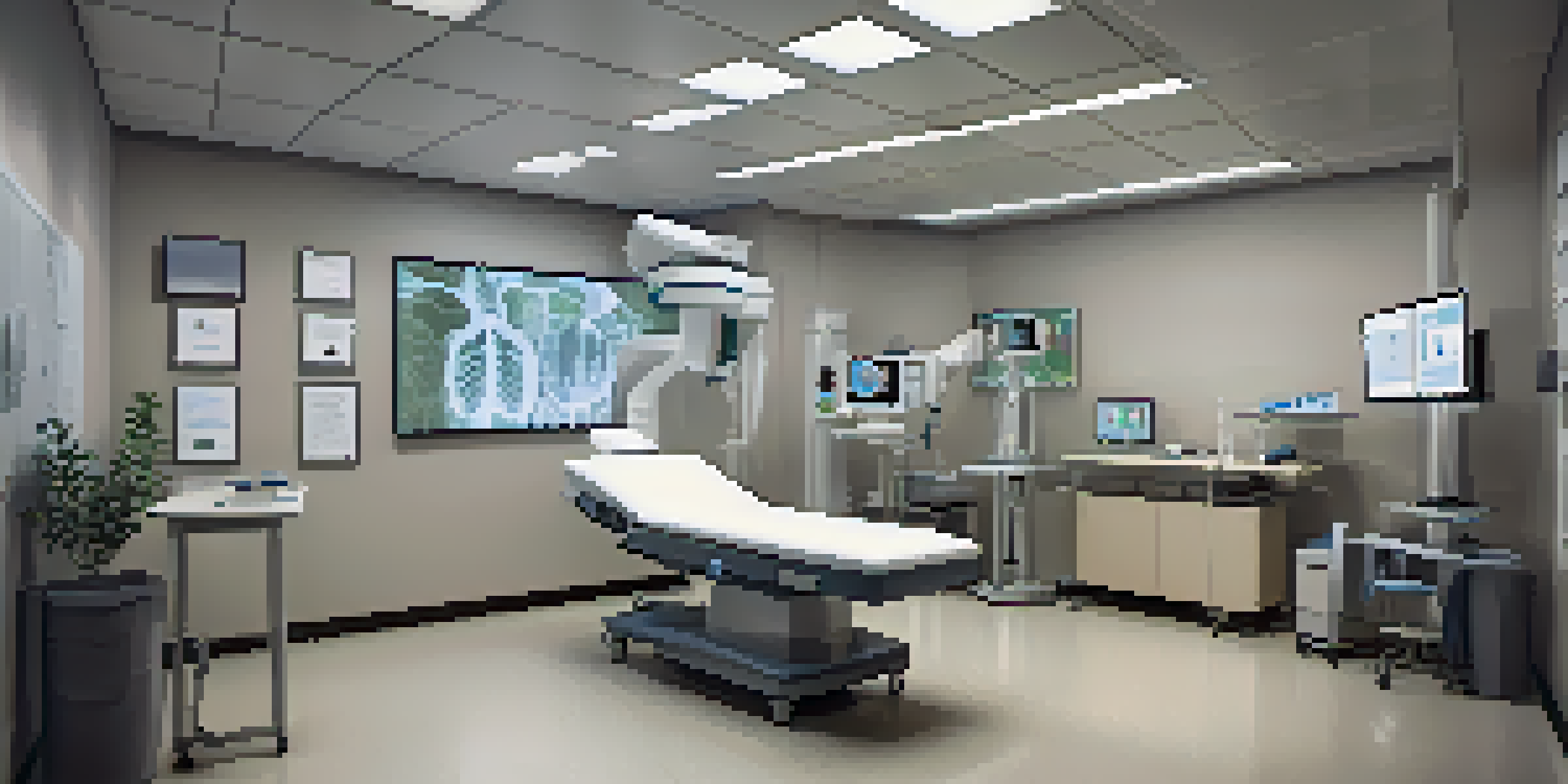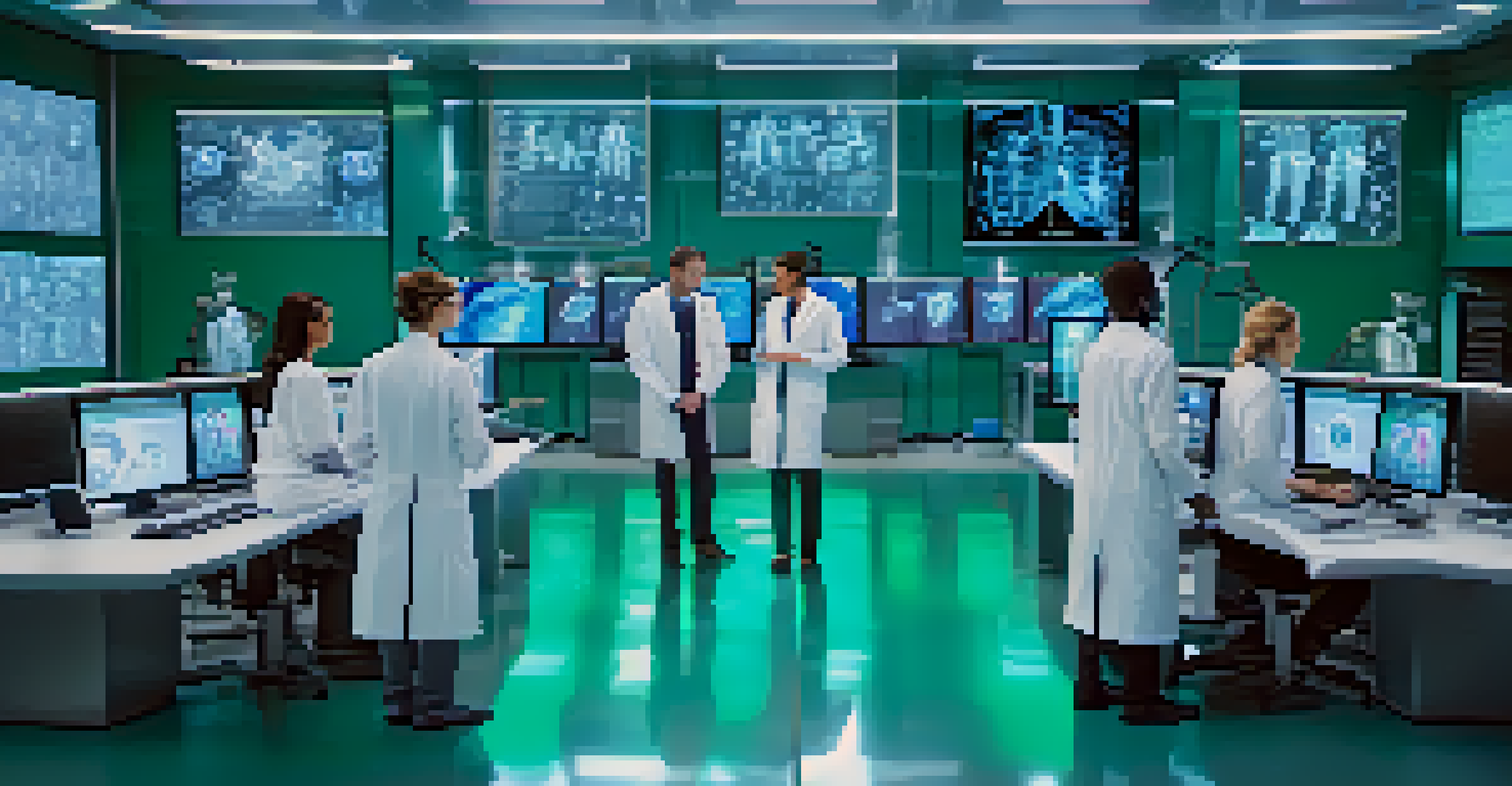AI Imaging Techniques: Revolutionizing Radiology Diagnostics

Understanding AI Imaging Techniques in Radiology
AI imaging techniques refer to the use of artificial intelligence to enhance and analyze medical images. This technology leverages machine learning algorithms to identify patterns and anomalies in imaging data, which can significantly improve diagnostic accuracy. For instance, AI can analyze X-rays, MRIs, and CT scans more quickly than a human radiologist, providing faster results for patients.
The greatest danger in times of turbulence is not the turbulence; it is to act with yesterday's logic.
By integrating AI imaging into radiology, healthcare professionals can streamline workflows and reduce the risk of human error. Imagine a busy hospital where radiologists are swamped with back-to-back cases; AI acts as a reliable assistant, prioritizing cases based on urgency and flagging potential issues. This collaboration between AI and radiologists enhances patient care by ensuring timely interventions.
Moreover, AI imaging techniques can continuously learn and adapt over time. As more data is fed into the system, the algorithms improve their performance, making them increasingly accurate at detecting diseases like cancer or fractures. This evolution makes AI not just a tool, but a vital partner in the diagnostic process.
Benefits of AI in Radiology Diagnostics
AI imaging techniques offer numerous benefits that can transform radiology diagnostics. One major advantage is the increased efficiency in image analysis, allowing radiologists to focus on complex cases that require human judgment. This time-saving aspect is crucial in emergency situations where every second counts.

Additionally, AI can enhance the accuracy of diagnoses, leading to better patient outcomes. For example, studies have shown that AI algorithms can match or exceed the performance of experienced radiologists in detecting certain conditions. This boost in accuracy means that patients receive appropriate treatment sooner, which can be life-saving.
AI Enhances Radiology Efficiency
AI imaging techniques streamline workflows, allowing radiologists to focus on complex cases and improve patient care.
Another key benefit is the ability of AI to reduce diagnostic disparities. In many healthcare settings, access to expert radiologists can be limited. AI imaging techniques can help bridge this gap, ensuring that even in remote or underserved areas, patients receive high-quality diagnostic services.
Challenges Faced by AI Imaging Techniques
Despite the many advantages, AI imaging techniques do face several challenges in the field of radiology. One significant concern is the quality and quantity of data required to train AI systems effectively. If the training data is biased or insufficient, the AI may produce inaccurate results, ultimately impacting patient care.
AI is not a replacement for humans; it is a tool that can help us make better decisions and improve our outcomes.
Moreover, there is a need for transparency in AI algorithms. Radiologists and healthcare providers must understand how AI systems make decisions to trust their recommendations. This calls for clear guidelines and regulations to ensure that AI tools are safe and reliable for clinical use.
Lastly, the integration of AI imaging techniques into existing healthcare workflows can be daunting. Radiology departments must invest in training their staff to work alongside AI systems and adapt to new processes. This transition requires time, resources, and a willingness to embrace change.
The Role of Machine Learning in Radiology Imaging
Machine learning, a subset of AI, plays a pivotal role in enhancing radiology imaging techniques. By using algorithms to process vast amounts of imaging data, machine learning can identify subtle patterns that may not be visible to the human eye. This capability is particularly beneficial in early disease detection.
For example, machine learning models can be trained to recognize early signs of conditions like pneumonia in chest X-rays, significantly improving diagnosis rates. As these models continue to learn from new data, their accuracy and reliability will only increase, providing radiologists with powerful tools for patient assessment.
Challenges in AI Implementation
The success of AI imaging in radiology hinges on high-quality data, transparency in algorithms, and effective integration into existing practices.
Moreover, machine learning can assist in predicting patient outcomes based on imaging data. By analyzing historical data, these systems can forecast complications or recovery trajectories, allowing healthcare providers to tailor treatment plans more effectively.
AI Imaging Techniques and Telemedicine Integration
The rise of telemedicine has opened new avenues for the application of AI imaging techniques in radiology. In remote settings, where access to specialists may be limited, AI can provide critical support by analyzing images and offering preliminary assessments. This capability allows for timely consultations, even from afar.
Furthermore, AI can enhance the telemedicine experience by providing real-time feedback to patients and healthcare providers. Imagine a scenario where a patient uploads their imaging results online; AI can instantly analyze the images and generate a report, facilitating quicker discussions with doctors during virtual appointments.
This integration not only improves patient experiences but also optimizes the use of healthcare resources. By enabling remote diagnostics, AI imaging techniques can help reduce the burden on hospitals while ensuring that patients receive the care they need without unnecessary delays.
Future Prospects of AI in Radiology Diagnostics
The future of AI imaging techniques in radiology diagnostics looks promising, with ongoing advancements poised to reshape the landscape of medical imaging. Researchers are continuously developing more sophisticated algorithms that can analyze images with unprecedented accuracy. This evolution holds the potential to revolutionize how diseases are detected and managed.
In addition, as AI technology becomes more accessible, we can expect broader adoption across healthcare settings. Smaller clinics and rural hospitals will likely implement these tools, ensuring that high-quality imaging services are available to a wider population. This democratization of technology is crucial for improving overall health outcomes.
Ethics in AI Imaging Use
Addressing ethical considerations, such as data privacy and algorithmic bias, is essential for the responsible use of AI in radiology.
Ultimately, the collaboration between AI and radiologists will continue to grow, leading to a more integrated and efficient healthcare system. As AI takes on routine tasks, radiologists will have more time to focus on patient interaction and complex decision-making, enhancing the overall quality of care.
Ethical Considerations in AI Imaging Techniques
As AI imaging techniques become more prevalent in radiology, ethical considerations must be taken into account. Issues such as data privacy and security are paramount, as sensitive patient information is often utilized to train AI models. Ensuring that this data is handled responsibly is essential to maintaining patient trust.
Another ethical concern involves the potential for algorithmic bias. If AI systems are trained on non-representative datasets, they may produce skewed results that disproportionately affect certain groups. It’s crucial for developers to actively work toward creating inclusive datasets that reflect diverse populations.

Lastly, the role of human oversight in AI diagnostics cannot be overlooked. While AI can enhance efficiency and accuracy, final interpretations should always involve a qualified radiologist. Striking the right balance between AI assistance and human expertise will be key to ethical and effective radiology practices.